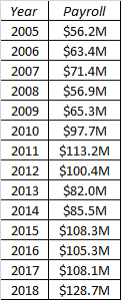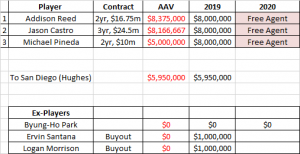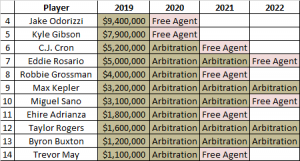The Major League Baseball Players Association has voted to extend the contract of executive director Tony Clark, according to Jared Diamond of the Wall Street Journal. His term of office is now due to run through 2022, meaning he’ll stay in charge through the duration of the five-year Basic Agreement he previously negotiated and lead the MLBPA as it prepares to hammer out a new one in 2021.
Clark, a long-time MLB player himself, took the top union post in December of 2013 after the untimely death of Michael Weiner. At the time, the sport was basking in the glow of booming economic growth and longstanding labor peace. The relatively pleasant pie-dividing process has more recently given way to some bickering at the table. Even as the money continues to stream in, teams have increasingly shown a reluctance to commit whopping future sums to relatively old free agents. That, in turn, has many questioning whether the MLBPA needs to craft a new strategic approach.
There are a whole host of interrelated factors at work, of course, including changes to the aging curve, the still-growing power of analytics in all aspects of the game, and perhaps also increasingly business-focused organizational leadership. And it’d be foolish to leap to any final conclusions about the nature of the player market. The best way to ensure revenue for a team, after all, is still to put a compelling product on the field. And the 2018 attendance drop no doubt was felt by some organizations. Competitive pressures still matter.
Still, the collective bargaining situation — in particular, the outcome of the 2016 negotiations — remains a notable factor in the changing labor market dynamics that have been met with no small amount of consternation by the players. As details of the 2016 CBA deal emerged, it became increasingly clear that the Clark-led union approach was one of tweaking the details of the existing system. There were modifications to the qualifying offer, a process that unfairly impacted a few veteran free agents but did not take a major bite out of the players’ overall take. The minimum salary crept up, as did the luxury tax line, and players added gained notable scheduling modifications and other changes to improve their lot.
At the same time, though, the MLBPA gave some notable concessions to the league that may well have dovetailed with other developments to hur the players’ collective bottom line. In particular, significant new penalties for spending over the luxury line held out the promise of constraining top-level payrolls. Meanwhile, a hard cap went in place for international signings, leaving virtually the entire amateur market subject to strict limits.
Those modifications have pressed established big leaguers from both sides, in a manner that was perhaps not easy to foresee in full. Teams are not only disincentivized from adding additional large salaries to finish off a roster, owing to the taxation scheme, but have less reason to do so given their ability to achieve excess value from young talent filtering up through the farm (which is cheaply replaced through the amateur market). An abundance of power arms, for example, has led to the cost-efficient approach of “bullpenning,” while big-market organizations like the Dodgers and Yankees have increasingly found ways to achieve excellent results without dishing out too many monster contracts. Of course, the more truly youthful players are pressed up to the majors, the sooner they’ll reach arbitration and free agency, and the more “prime” years they’ll have to sell.
It will likely take some time for the market changes to settle out and reveal themselves in full. Still, the problems from the players’ side were on display last winter, as numerous veterans found less receptive markets than they had anticipated. Clark went on a PR blitz as the market stagnated and filed a grievance against four teams that accuses them of failing to properly spend their revenue-sharing funds. As a practical matter, though, there wasn’t much that could be done at that point.
For Clark, looking ahead, there are strategic challenges aplenty. The union may need to consider trying more radical changes to its approach, which has traditionally benefited the most-established ballplayers while leaving relative crumbs for young major leaguers and high-end incoming amateurs (and actual crumbs for most minor-leaguers). Gambling money is another potentially game-changing financial boon for teams — and one that the players will not only want a piece of, but could utilize to their advantage from a public relations standpoint.
No doubt there are many possible strategies on the table. With a new lead negotiator to assist him, Clark is surely preparing for the 2021 CBA negotiations and the interim actions that might be taken. As veteran reliever Andrew Miller puts it, “We have confidence in Tony with where we are and where we’re going.”



